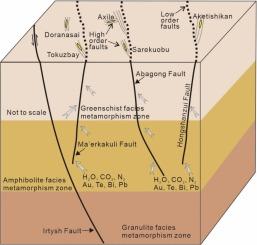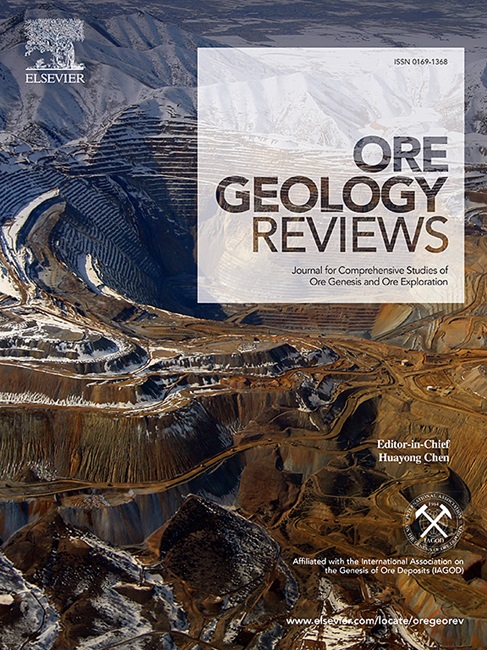Formation of the intrusion-hosted orogenic-type gold lodes: Exemplified by the Axile gold deposit in the Chinese Altai
IF 3.2
2区 地球科学
Q1 GEOLOGY
引用次数: 0
Abstract
Unlike the gold deposits typically hosted in metamorphosed volcanic-sedimentary sequences, the recently discovered Axile gold deposit (over 13 t Au at 5.35 g/t) is a unique example in the Chinese Altai for evaluating the genesis of intrusion-hosted lode gold deposits in metamorphic terranes. The orebodies in this deposit occur as quartz veins and altered tectonites hosted in the sinistrally sheared quartz diorite and biotite granite zones in the Habahe intrusion. The quartz vein-type ores are composed of quartz-pyrite veins and quartz-polymetallic sulfide veins, in which gold-tellurides also occur. The altered tectonites, spatially associated with the quartz veins, are composed of deformed and altered rocks of quartz diorite and biotite granite. Main alterations include quartz, sericite, calcite, chlorite, albite, pyrite, chalcopyrite, and gold-tellurides. Two types of fluid inclusions are identified in the ores, i.e., (1) carbonic-aqueous (C-type) and (2) aqueous (W-type), with the C-type being dominated. These fluid inclusions yield salinity ranging from 3.6 to 9.0 wt% NaCl equivalent and homogenization temperatures in the range of 249 − 387 ℃, suggesting a typical mesothermal NaCl-CO2-H2O system. The Axile deposit thus corresponds to an orogenic-type gold deposit.
The hydrothermal titanites in the auriferous quartz-pyrite veins yield in situ U-Pb ages around 278.4 ± 2.4 Ma (MSWD = 3.1, 2σ), which constrain the gold mineralization timing as Permian. The mineralized quartz diorite and biotite granite yield zircon U-Pb ages of 377.0 ± 1.0 Ma (MSWD = 0.1; 1σ) and 394.0 ± 1.2 Ma (MSWD = 0.4; 1σ), respectively, which show that the ore-hosting intrusions were emplaced in the Devonian, obviously earlier than the gold mineralization. The light δ13CV-PDB values (−15.5 ‰ to −6.7 ‰, average −10.7 ‰) of the CO2 extracted from the fluid inclusions display a significant contribution from the organic carbon in sediments. Given the sedimentary rocks underwent Permian greenschist to amphibolite facies metamorphism in the Chinese Altai, accompanied by the synchronous structural deformation and shearing activities, it could be concluded that the Axile gold deposit is formed by a shear zone-controlled mesothermal system that originated from metamorphic-devolatilization. The Chinese Altai Orogen is an orogenic-type gold metallogenic belt, containing both the intrusion- and metamorphic rock-hosted gold deposits, illustrated by a consistent genetic model.

侵入成因型金矿床的形成:以中国阿尔泰的阿西勒金矿床为例
与通常赋存于变质火山-沉积岩序列中的金矿床不同,最近发现的阿西勒金矿床(金品位超过13吨,每吨5.35克)是中国阿尔泰地区评估变质地层中侵入赋存型金矿床成因的一个独特实例。该矿床的矿体以石英脉和蚀变构造岩的形式赋存于哈巴河侵入体中的蜿蜒剪切石英闪长岩和生物花岗岩带中。石英脉型矿石由石英黄铁矿脉和石英多金属硫化物脉组成,其中也有金碲。与石英脉在空间上相关的蚀变构造岩由变形和蚀变的石英闪长岩和生物花岗岩组成。主要蚀变物包括石英、绢云母、方解石、绿泥石、白云石、黄铁矿、黄铜矿和金碲化物。在矿石中发现了两种类型的流体包裹体,即(1)碳水溶液(C 型)和(2)水溶液(W 型),其中以 C 型为主。这些流体包裹体的盐度在 3.6 至 9.0 wt% NaCl 当量之间,均化温度在 249 - 387 ℃ 之间,表明这是一个典型的中温 NaCl-CO2-H2O 系统。因此,Axile矿床属于造山型金矿床。含金石英黄铁矿矿脉中的热液榍石产生的原位U-Pb年龄约为278.4 ± 2.4 Ma (MSWD = 3.1, 2σ),将金矿化时间确定为二叠纪。矿化的石英闪长岩和生物花岗岩的锆石 U-Pb 年龄分别为 377.0 ± 1.0 Ma (MSWD = 0.1; 1σ) 和 394.0 ± 1.2 Ma (MSWD = 0.4; 1σ),这表明矿床侵入体是在泥盆纪形成的,明显早于金矿化时间。从流体包裹体中提取的二氧化碳的轻δ13CV-PDB值(-15.5‰至-6.7‰,平均-10.7‰)显示沉积物中的有机碳对其有很大贡献。鉴于沉积岩在中国阿勒泰地区经历了二叠纪绿泥石到闪长岩的变质作用,并伴有同步的构造变形和剪切活动,可以断定阿西勒金矿床是由剪切带控制的介热系统形成的,该介热系统起源于变质-变质作用。中国阿尔泰造山带是一个造山型金成矿带,同时包含侵入岩和变质岩金矿床,其成因模式是一致的。
本文章由计算机程序翻译,如有差异,请以英文原文为准。
求助全文
约1分钟内获得全文
求助全文
来源期刊

Ore Geology Reviews
地学-地质学
CiteScore
6.50
自引率
27.30%
发文量
546
审稿时长
22.9 weeks
期刊介绍:
Ore Geology Reviews aims to familiarize all earth scientists with recent advances in a number of interconnected disciplines related to the study of, and search for, ore deposits. The reviews range from brief to longer contributions, but the journal preferentially publishes manuscripts that fill the niche between the commonly shorter journal articles and the comprehensive book coverages, and thus has a special appeal to many authors and readers.
 求助内容:
求助内容: 应助结果提醒方式:
应助结果提醒方式:


